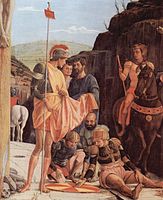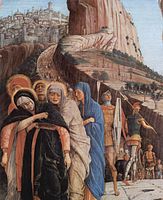art.wikisort.org - Painting
The San Zeno Altarpiece is a triptych by the Italian Renaissance painter Andrea Mantegna, from c. 1457–1460. It is located in the Basilica di San Zeno, the main church of Verona. The three predellas, stripped by the French in 1797 along with the main picture (restored to Verona in 1815), have been replaced by copies. The originals are in the Louvre (Crucifixion) and in the Musée des Beaux-Arts in Tours (Resurrection and Agony in the Garden).
This article includes a list of references, related reading or external links, but its sources remain unclear because it lacks inline citations. (December 2019) |
| San Zeno Altarpiece | |
|---|---|
 | |
| Artist | Andrea Mantegna |
| Year | 1457–1460 |
| Medium | Tempera on panel |
| Dimensions | 212 cm × 460 cm (83 in × 180 in) |
| Location | Basilica di San Zeno, Verona |
The work was commissioned by the Abbot Gregorio Correr. In the centre is the Madonna enthroned with the Child, portrayed according to the Byzantine iconography of the Victorious Madonna and surrounded by chanting angels. Eight saints are placed at the sides, according to the commissioner's preferences: on the left are Peter, Paul, John the Evangelist and Zeno; on the right, Benedict, Lawrence, Gregory and John the Baptist.
The entire composition is full of detail referring to classical antiquity: the frieze with the angels which holds two garlands, or the throne which reminds the viewer of a sarcophagus. The frame, probably designed by Mantegna himself, is the original one.
It was probably the first good example of Renaissance art in Verona. It served as a model for other painters including Girolamo dai Libri.
Predella
- The central panel (The Crucifixion)
- Detail of the central panel
- Detail of the central panel
References
External links
| External video | |
|---|---|
 A study made for the painting, now at the Getty Museum A study made for the painting, now at the Getty Museum | |
На других языках
[de] San-Zeno-Altar
San-Zeno-Altar wird ein Triptychon genannt, das für den Hochaltar der Kirche San Zeno Maggiore in Verona geschaffen wurde. Die insgesamt sechs Einzelgemälde, drei große Tafelbilder und drei kleinere der Predella, wurden zwischen 1457 und 1460 von Andrea Mantegna geschaffen. Die Arbeit ist eines seiner Hauptwerke[1] und gilt als eine Meisterleistung seiner Zeit.[2] Es handelt sich um den ersten Hochaltar der Renaissance, bei dem die neue Auffassung des Realismus durchweg angewandt wurde.[3] Zudem wurde zum ersten Mal im Norden Italiens eine „Sacra Conversazione“ dargestellt.[4]- [en] San Zeno Altarpiece (Mantegna)
[es] Retablo de San Zenón
El Retablo de san Zenón es un tríptico del pintor renacentista italiano Andrea Mantegna, datado de h. 1457-1460. Se encuentra ubicado en la Basílica de San Zenón, la principal iglesia de Verona. Las tres predelas fueron saqueadas por los franceses en el año 1797, y actualmente están reemplazadas por copias. Los originales se encuentran actualmente en el Louvre (Crucifixión) y en el museo de Tours.[fr] Retable de San Zeno
Le Retable de San Zeno est le retable du maître-autel de la basilique San Zeno, l'église principale de Vérone. Il comporte des parties peintes en polyptyque du peintre de la Renaissance du Quattrocento Andrea Mantegna, ensemble daté d'environ 1457-1460.[it] Pala di San Zeno
La Pala di San Zeno è un dipinto, tempera su tavola (con la cornice 480×450 cm, scomparto centrale 125×212, sinistro 135×213, destro 134×213), di Andrea Mantegna, datata tra il 1456 e il 1459 e custodita nella sua collocazione originaria, sull'altare maggiore della basilica di San Zeno a Verona. Si tratta della prima pala d'altare pienamente rinascimentale dipinta in Italia settentrionale, che ispirò la scuola di pittori rinascimentali veronesi, come Girolamo dai Libri. Fu oggetto delle spoliazioni napoleoniche della Repubblica di Venezia.Другой контент может иметь иную лицензию. Перед использованием материалов сайта WikiSort.org внимательно изучите правила лицензирования конкретных элементов наполнения сайта.
WikiSort.org - проект по пересортировке и дополнению контента Википедии


